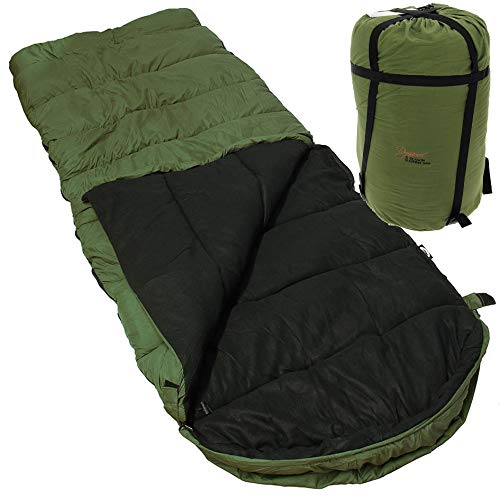If you like to go carp fishing throughout the year, there will be times, especially during autumn and winter, when you are heading to the lake when it’s cold and overcast.
Comfort plays a huge part in how much enjoyment you get out of those long hours you patiently sit waiting for any interest in your bait and lures. No-one wants to spend a day by the lake or estuary feeling cold damp and miserable. That doesn’t sound like fun does it? That could bring your nice and relaxing day of carp fishing to a grinding halt pretty quickly.
With that in mind, therefore, it makes sense you will want to keep your bivvy as dry and warm as you possibly can so you can enjoy your fishing.
Contents
Top Ways To Stay Warm
Choose Your Fishing Spot Carefully
By far the first and best way you be sure your bivvy has a good chance of staying as warm as it can be from the get-go is by choosing where you set it up wisely. It is usually good to set up facing in the direction of your rods and therefore out onto the body of water you are carp fishing. However, during winter, this is not the best idea. Even if you would prefer to not be completely sheltered, so you have better visibility of what is happening with your fishing rods, you should look for a spot that has some shelter at least.
Pay attention to which direction the window is predominately blowing in and try to set up with trees or other foliage. This will help keep the temperature higher in your bivvy.
Insulate the flooring and Make Full Use of the Groundsheet
When you are fishing in the colder and less pleasant months of the year and setting up, you need to properly guard against the damp, cold and moisture that could rise from the ground upwards and into your bivvy. You should always use the insulation ground sheet that came with it and if one was not supplied with it, you should invest in one.
You mustn’t just lay it down and think that will be enough protection. You need to make sure there are no gaps and that it offers a nice tight and snug fit.
Make sure you tuck all the mud flaps around your bivvy underneath the groundsheet to stop draughts and, where appropriately, use equipment and pieces of your kit to hold the groundsheet and insulation down and keep the draughts to a minimum.
Use The Wrap or Winter Skin
There are many carp fishing bivvies out there that come equipped with a winter skin or an overwrap. This is an accessory that can be placed over the top to provide it and you with an extra layer of insulation from the cold. Don’t worry about damp or condensation, as these tend to be made from breathable materials that allow for an adequate amount of airflow to prevent the build-up of moisture.
Properly Pegged
Make sure when you peg it down that the fabric is as taught as you can get it. If you are using a winter skin or overwrap, as suggested above, you need to make sure that is peg tightly too, but that there is a gap between the wrap and the skin to prevent the build-up of condensation and moisture.
It is also wise to keep a spare pack of pegs; in case anything happens to your main set. Remember that long pegs are designed for use in soft ground and high wind conditions, whereas shorter pegs are best used for firmer ground.
Invest in a Good Quality, But Safe Heater
One way to keep warm while fishing is by bringing warmth into it with the use of a bivvy heater. However, you need to be careful when choosing one, as there have been many instances of anglers being involved in accidents where they have been badly injured or lost their life due to carbon monoxide poisoning or their bivvy combusting in. Therefore, avoid any heater that produces carbon monoxide and it is also sensible to avoid anything involving naked flames.
Always choose a heater that has been designed for the intended purpose.
Pack a Hot Water Bottle and Hand Warmers
Following on from the above tip, a very easy, but incredibly effective way to keep your carp fishing bivvy warm, or more accurately, you warm inside, is with a hot water bottle. Not only can these be picked up for a relatively low price, but they are also completely safe to use.
Hand warmers are also an easy and safe way to keep your digits warm (where a lot of the heat stored in your body will escape from).
Clothing Items
Moving on nicely from the above, you also need to make use of the heat your own body produces to help protect you from the cold. With that in mind, it is wise to invest in high-quality thermal underwear, a base layer, a hoody and a waterproof jacket to keep your body temperature high.
Sleeping Bag
If you are intending on being out for more than just the one day, you will want a sleeping bag. Having said that, even if you are not going on a full trip, a sleeping bag is still a sensible investment to keep you fully protected.
You have two options. You can either choose an insulating bag to use during the winter months and switch to a lightweight model for the warmer months or you could purchase an all-season sleeping bag for use throughout the entire year.
We would highly recommend either a 4 or 5-seasons rating.
How you use it can also help increase the level of warmth you experience. Though it may sound counterintuitive, it is advisable to take off some layers of your clothing. This will help you to stay warmer for longer, and your body heat will help warm inside.
Sleeping with fewer layers on will also feel more comfortable and you will benefit from those extra layers when you put them back on before leaving your bivvy again.
If you still feel too cold and uncomfortable, you can then use the extra layers of clothes you removed over the top of the sleeping bag like blankets or invest in some bivvy slippers to help keep your feet warm.

Mike has over 30 years of fishing experience in carp fishing and general coarse fishing. He is always looking for the latest fishing kit to try out and talk about and needs a bigger shed due to all the fishing tackle he owns. You can read more about him here.





